On this page we’re checking out the Topping L50 Desktop Amplifier.
Topping L50 NFCA Balanced Desktop Amplifier
The Topping L50’s dedicated web page can be found here. It costs $229 USD from Shenzhen Audio.
Topping L50 is a budget-oriented, high-performance NFCA amplifier. It offers 3 stages of gain, a very low THD, very low output impedance, and it can deliver 3.5W of power into a 16-ohm load. The nested feedback composite amplifier circuitry makes sure that the noise level is well below the audible threshold to offer a better, darker background that pairs well with both efficient and inefficient earphones and headphones. I have listed the highlights of the L50 below.
- NFCA Circuitry
- Superbly Low THD & Superbly High DNR
- Superbly Low Noise Floor
- 3.500mW into 16Ω
- Output Impedance of <0.1Ω
- Balanced TRS + Unbalanced RCA
- Passthrough TRS & RCA
- Future Firmware Support
Packaging & Accessories
Topping’s L50 amplifier comes in a medium-sized, white rectangular box just like its brother, the E50. The box design is simple and there are no specifications or any product info listed anywhere on the box. There is a sticker with the model name and barcode on the side of the box and that’s pretty much it. Upon opening the box, you’re welcomed by the foam compartment that protects the device from damage during transportation. As for the accessories, Topping provides you with a heavy AC transformer, 6.35 to 3.5mm adapter, and, a couple of manuals. Unfortunately, Topping does not provide the TRS to XLR adapters that come with the D10 Balanced DAC. I would want Topping to include them with the L50, as well. Additionally and unfortunately, there is no remote support for this unit.
Design & Build Quality
Measuring 12.9 x 16.6 x 4.1 centimeters, the L50 amp shares pretty much the same form and factor as the E50. It is naturally the perfect companion to the E50 DAC. It has a small footprint and it won’t take much space on your desk. It is aesthetically similar to the older L30 except for the XLR out on the front panel. The device features an aluminum body and a glass front panel and Topping offers it in 4 different colors. It is available in black, red, blue and silver. The review unit they sent me is in silver color and it looks very handsome up close. It has a metallic, anodized finish and texture. Additionally, the volume pot matches the exterior finish of the unit and I think it is a very nice touch. I can’t see any assembly issues or imperfections so the build quality is top-notch as usual with Topping products. There are 4 rubber feet under the device, helping it to stay put on your desk.
Let’s talk about the layout. On the front of the device, we see the color-matched volume pot, two nostalgic level-style switches, a single-ended 6.35mm headphone out, and a balanced XLR out. The far-left switch acts as a power switch and output selector at the same time. The other switch is purely for controlling the gain. There are 3 gain options, low, medium and, high. The layout is simple and easy to use. The switches are very practical and they seem pretty durable.
All the I/O options are located on the rear side of the amplifier. From left to right, we see TRS inputs, RCA inputs, RCA passthrough, TRS passthrough, 15VAC barrel power connector, and lastly a USB-C connector. Especially the last part got me very excited because we don’t see a lot of those on amps, especially in this price bracket. It is very satisfying to see that they included a USB-C port for future firmware updates. Excellent job, Topping, excellent job indeed.
Similar to the E50, the L50’s build quality is top-notch and it is built to last. The connectors and switches feel durable and rigid. If you tend to use ultra-short cables between your dacs and amps, you should know that both RCA and TRS sockets align so you can achieve perfect cable management with this stack. I can’t find anything negative about the build quality or design. This stack is a job well done.
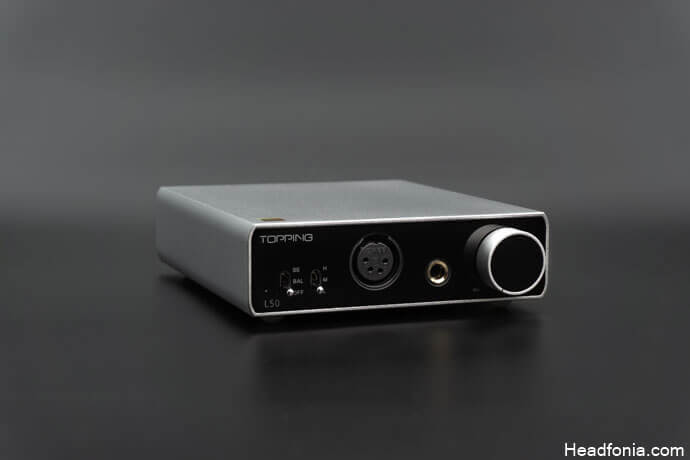
Technology & Power
The L50 is quite a powerful amplifier. It can dish out 3.5W into a 16Ω load and 290mW into a 600Ω load. It utilizes the nested feedback circuitry and offers a practically non-existent noise floor. It has three gain options and here are the details of gain modes: L=-14.5dB, M=-0.3dB, H=+13.7dB. This means that it will have no trouble feeding 95% of the headphones on the market right now.
Additionally, the L50 features an impressively low output impedance of just 0.1Ω. I have paired my most sensitive IEMs with it but I couldn’t hear any hiss. The background was as black as it gets. Furthermore, the L50 is an impressive amp, on paper, as well. The SNR, DNR, and THD values are certainly interesting for this price bracket and the sound performance is on par with the measurements on the paper.
Controls & Operation
The L50 is a very practical device when it comes to operation. You connect the AC transformer to the 15VAC power socket and switch on the most left switch to BAL or SE, depending on your configuration. There is a small white power LED next to that switch to let you know about the status of the device. As for future firmware updates, make sure you check this page once in a while. If you encounter any issues with the device, you can consider restoring it to factory settings by pressing volume down, volume up, and mute buttons simultaneously while the device is in standby mode. That’s pretty much it!
AMP Performance
My experience with NFCA amplifiers has been quite positive. The amplifiers have come a long way compared to a year before and I am very satisfied with the technological leap they made. The L50 sounds dead neutral to my ears and it does exactly what it should. It amplifies without saturating, distorting, or changing the sound signature of your source, IEMs or HPs. It does a very good job of conveying the signature of your gear to you and that’s all. The L50 performs very well from a technical standpoint and let me try to explain why. First of all, thanks to its design, it is very linear, detailed, and resolving. Secondly, it offers a brilliantly silent background, and finally, it has heaps of clean power available 7/24 on demand.
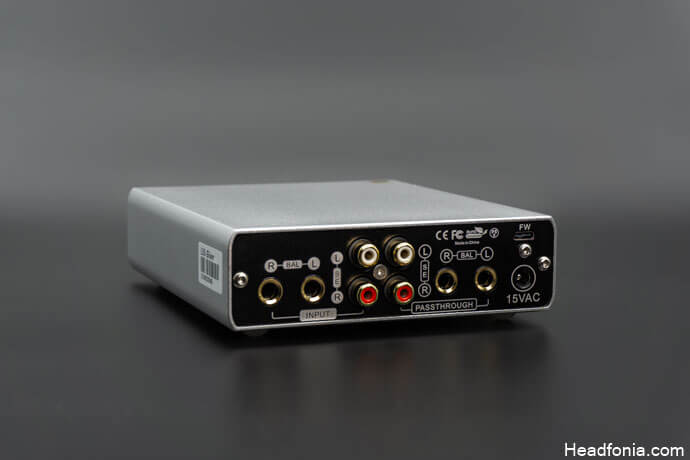
The E50 sounds precise, accurate, and tonally correct to my ears without sounding harsh or tiring. I paired the L50 with the Gustard X16 to see whether it scales well with higher-priced equipment and the results were quite good. Gustard X16 is a very detail-oriented DAC that has a way of emphasizing macro and micro details and present them to you. The L50 acted as an amplifier, a middleman, and nothing more, I heard the signature of the X16 without any saturation, coloration, or manipulation. The L50 can easily be paired with DACs that cost double its price tag.
The L50 offers great control across the entire frequency range and it is surprising to see how clean it stays while I am pushing the limits of my headphones just to see whether it will distort or not. Combine this amount of clean power with a very clear, silent background and you’ll have the recipe for trouble.
The review continues on Page Three, after the click HERE or by using the jump below.
Page 1: Topping, Topping E50 Desktop DAC, Packaging & Accessories, Design & Build Quality, Technology Inside, Controls & UI, DAC Performance
Page 3: Topping E50 & L50 DAC & AMP Stack Performance,Comparisons, Pairings, Last Words






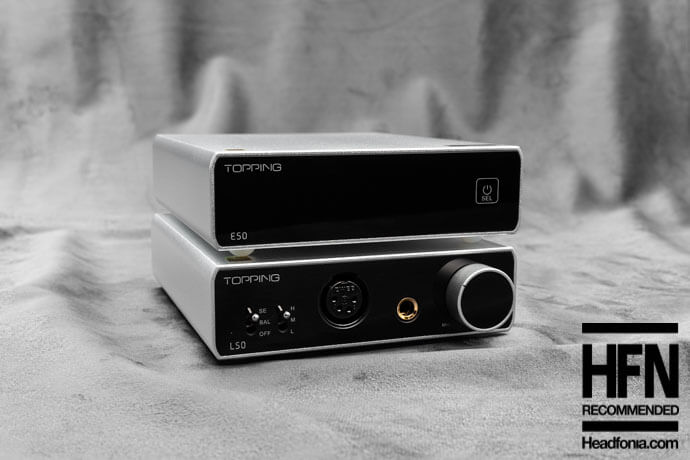
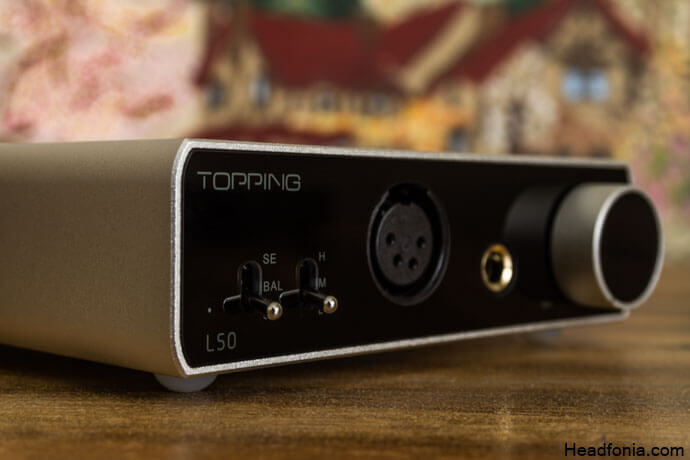
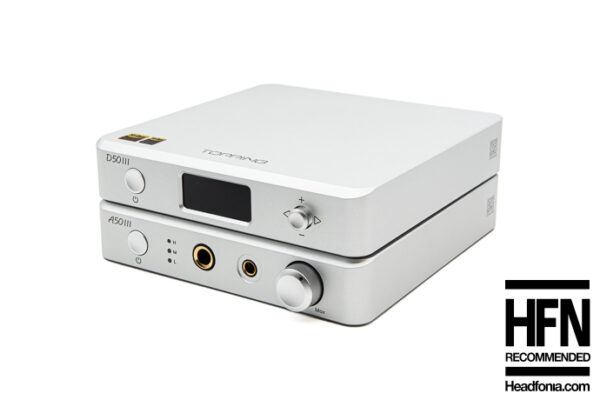

James McCook
Awesome review, ordered!!!!!
Mike
It sound little harsh in my stereo. E30 didnt sounded like this. Its heavy to listen for even few periods.
I have a raspberry 4, use flac and dac connected with rca to a onkyo amplifer. I have a pair of focal chorus. Bass are ok, but voices are harsh when goes high notes. This is my impression, and i read another user that tried to limitate this harshness, by going in preamp mode and -25 volume. But i hear the same. No way for me, sorry
Darwin
$269 and no power adapter??? I hope they enjoyed their minuscule savings, I won’t be buying one.
David Campbell
I’ve seen this movie before. Chi-Fi stepping up their game and indulging in profit. Lots of their signature black or silver box’s. Standard LED display with remote. Topping WAS a brand from 8 years ago at least that provided a bargain, or a good a deal. Today, not so much. The$300 range up or down a bit is the new $99 each from way back. Here’s the thing, it’s the same black or silver box with an updated circuit board and offering MQA as a selling point. I also used to believe in MQA. Things really got upended when Apple Music became lossless last year. Phenomenal quality NOT from compressed MQA. No sir, I understand the compression or lack there of for MQA tracks. Now I listen PRIMARILY to Apple lossless everywhere at home. Then Alexa does most everything else around the house along with her Amazon lossless files.MQA is sold on the fact that it’s truly portable. This setup is obviously meant for home use pluggwd in. So, why be at home plugged in X 2 anchored to a desktop when I can buy (and I did) a DAP w/OB MQA? Remember, MQA is certified as high res BUT, MQA is also compressed. Let me stop here!
Yagiz
Hello David, I hope you are well and thanks for your comment.
I think the MQA should not be a deciding factor. Almost all DACs now support MQA now.
I personally don’t really care about MQA as long as it’s a successful DAC.
Indrajit
Hi. I have a Topping E30 + Magni 3 and a Sennheiser hd 650. I want to upgrade my amplifier. I am planning to buy a Topping L50. May I know if the Topping L30 provides the same power output via single ended as it does with balanced? I have come across readings on internet which suggest that L50 is implicitly a single ended amp.
Yagiz
L50’s high gain is capable of delivering 600mW under 300 ohm load whereas L30 delivers around 110 mW. Why do you want to upgrade though? Both of the amplifiers are perfectly suitable with the HD650 and both of them are excellent amplifiers.
Indrajit
Hi. There was a typing error on my end. I meant to say that all the topping amps such as L30, L50 provide max power output as advertised on their websites only when the amps are fed through a dac which is an XLR input which is usually rated as 4vrms. Thus the topping L30 and L50 are not anywhere nearly as powerful as they are advertised to be at 300 ohm if they are fed through a traditional 2vrms input dac like the E30. This is my biggest concern and thus has me wondering how much power output would L30 and L50 really unleash via a traditional 2vrms input dac such as E30.
Reinhard
Hey. I wat to upgrade my e10k fiio to this. But what do you prefer best between this and smsl su sh 6 stack?
Yagiz
I’d personally go with the E50 & L50. Better overall technical capability & res. I’d also get a decent TRS cable. (Topping has a good one, alternatively you can check Aliexpress or Taobao.)
Best of luck mate.
José Countinho
im so hesitating between e50 and the new k7… purely as a dac for my speaker system (rega brio, wharfedale diamond 12.2). just soundwise, what´s better?
Thank you in advance. Great article, great website!
Yagiz
Hello Jose, as a pure DAC, definitely E50.